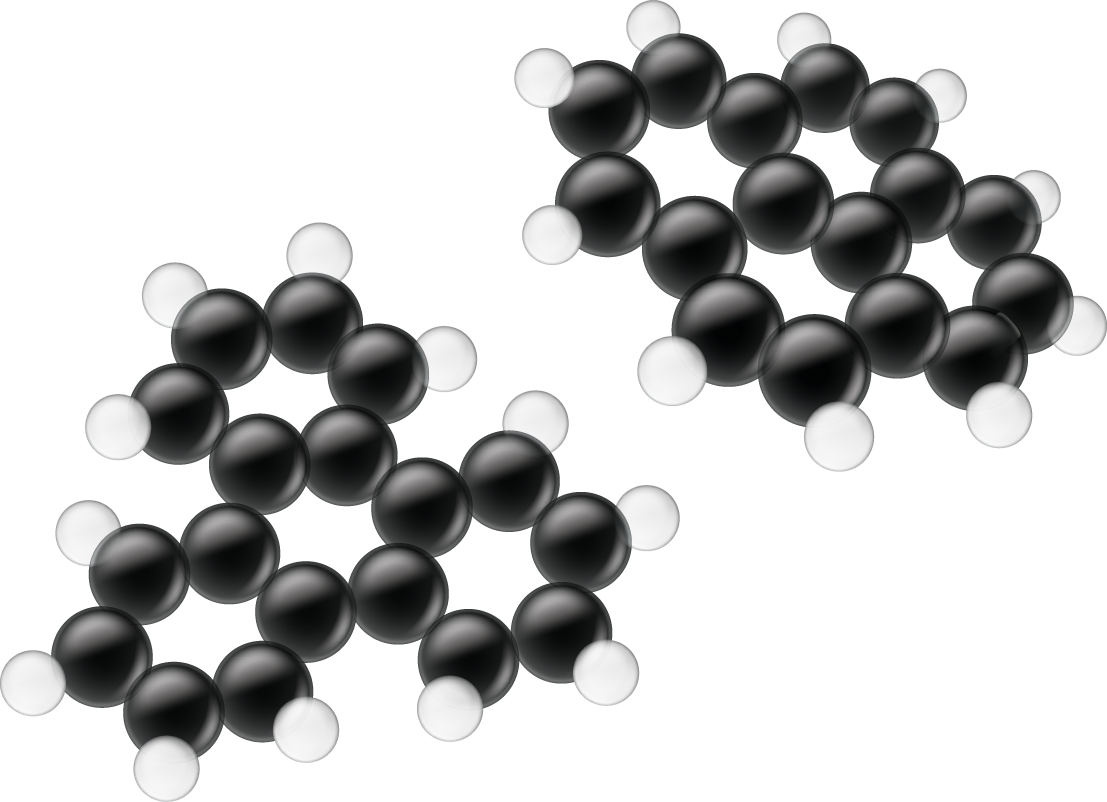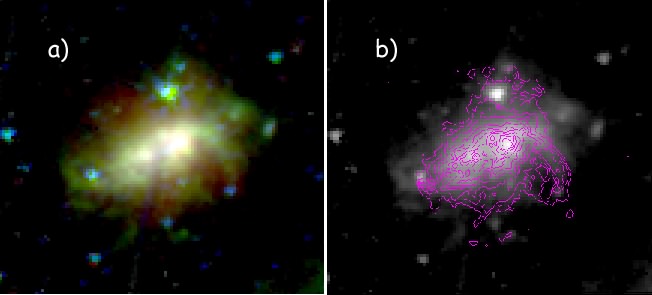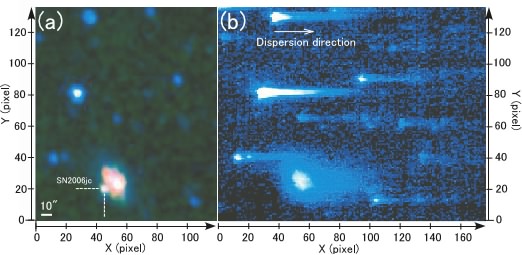Latest Research Topics
AKARI reveals evolution of interstellar organic material (Mori et al. 2014)
In between stars, there is interstellar matter, which consists of gas and small solid particles (dust). At the boundary between gas and dust, tiny small particles were dsicovered in the 1970's and they are now identified as polycyclic aromatic hydrocarbons (PAHs) or interstellar organic matgerial. AKARI observations have revealed their processing and evolution process in the interstellar space.

Schematic figure of PAHs

PAH spectrum taken by the Infrared Camera (IRC) on board AKARI

Schematic figure of PAHs

PAH spectrum taken by the Infrared Camera (IRC) on board AKARI
Detection of the optical transient in NGC300 with AKARI (Ohsawa et al. 2010)
AKARI detected infrared radiation from the optical transient in the nearby galaxy NGC300. The optical transient is a phenomena similar to supernova explosion. The infrared radiation is thought to come from the dust formed in the explosion. The detection was made twice; 398 and 582 days after the explosion. The observations at the two epochs enable us to estimate a lower limit of the mass of the dust formed and to obtain evidence for asymmetric explosion. These results are significant for the study of dust formation associated with supernova explosion, which is thought to be important in the early Universe.Chilarity produced by supernovae (Boyd et al. 2010)
Exclusive presence of left-handed amino acids over right-handed ones (enantiomerism) is a longstanding puzzle in astrobiology. Here we propose a new mechanism that could end up with the present chirality preference. Difference in reactions of neutrinos with 14N between the opposite sides of a neutron star results in preferential destruction of 14N aligned with the magnetic field. The imbalance due to this mechanism is estimated to be small, but it could be enhanced in the Galaxy. This work is led by Dr. Richard Boyd (LLNL) in collaboration with Prof. T. Kajino (NAOJ).Public Release of the
AKARI Mid-Infrared All-Sky Survey Catalog (Ishihara
et al. 2010)
AKARI detected about 870,000 infrared sources at mid-infrared (9 and 18
micron) in its all-sky survey. The point source catalog of the
survey has been released to the public. It surpasses the past
IRAS survey in the spatial resolution and sensitivity by an order of
magnitude, providing the new-generation infrared database for various
astronomy fields. AKARI is a JAXA project with the participation
of ESA. This work is carried out with the ISAS as well as the
ESAC.
AKARI mid-infrared point source distribution in the Galactic coordinates (©JAXA)
Ice Chemistry in the
Large Magellanic Cloud (Shimonishi
et al. 2010)
Ice is an important ingredient for formation of planets, but its
formation process still remains unclear. The Magellanic Clouds
provide quite unique environments of low metallicity, whose effects on
the ice chemistry give us significant information on the ice chemistry
in the interstellar space. In fact we found that the CO2 ice
abundance in the Large Magellanic cloud, where the metal abundance is
about a half of our neighborhood, has different ice chemistry.
The abundance of CO2 ice is much larger in young stellar objects there
than in our Galaxy. The data were taken with AKARI, a JAXA
project with the participation of ESA, as part of the AKARI Large
Magellanic survey program (Ita et
al. 2008).Organic material ejected from the galaxy NGC1569 (Onaka et al. 2010)
AKARI detected infrared radiation characteristic to interstellar organic material in the galactic wind from the galaxy NGC1569. NGC1569 is a small galaxy with strong star-formation activities. The galactic wind triggered by the star-formation entrains interstellar material in the galaxy disk and ejects it to the intergalactic space. AKARI revealed the presence of organic material in such a large scale around galaxies for the first time. The expected short life time in a windy train suggests that the organic material may have been produced by the shock at the interface between the wind and the inter galactic space, suggesting a possible formation process of organic material in space.
AKARI infrared images of NGC1569. (a) A 4 (blue), 7 (green), and 15 (red) micron artificial color image. The 7 micron (green) detects infrared light characteristic to interstellar organic material. The green bar structure extending down from the right edge of the galaxy disk indicates the presence of the organic material in this structure. (b) The 7 micron image (gray scale) with the H alpha emission (contours). The H alpha emission comes from the ionized hydrogen gas formed by the wind shock. The association of the H alpha emission with the 7 micron emission suggests that the organic material seen at 7 micron is produced by the shock.
Warm debris disks around main-sequence stars detected by AKARI (Fujiwara et al. 2010)
AKARI all-sky survey at mid-infrared (9 and 18 micron) detected a number of interesting stellar sources. They are called warm debris disk objects. Debris disks are the disks detected around a normal star by the IRAS survey. They are cool (<100K) disks located far from the central star and thought to be produced by collisions by large bodies. Debris disks detected by AKARI are, on the other hand, much warmer (>100K) and located near the planet formation region and thus more interesting objects in the frame of planet formation. These warm debris disks show further striking phenomena. Follow-up observations with Spitzer indicate that they are associated with a appreciable amount of minerals rare in the interstellar space, such as enstatite and silica. This fact indicates possible processing on large bodies in warm debris disks.AKARI detected infrared emission from supernova 2006JC (Sakon et al. 2009)
AKARI detected infrared emission from dust formed in the ejecta of supernova 2006JC in the galaxy UGC4904. Dust formation in supernova ejecta is thought to be important for the understanding of evolution of galaxies in the early Universe and the present observation provides us with useful constraints on the amount and composition of the dust formed in the ejecta. Our observation indicate that the dust is mostly composed of amorphous carbon grains and the estimated amount of the dust is far below the prediction. It also suggests that the dust formation in the progenitor stage may be important.
Observed image of SN2006jc at 3 micron (left) and its slitless spectroscopic image (right).
Go back to Research